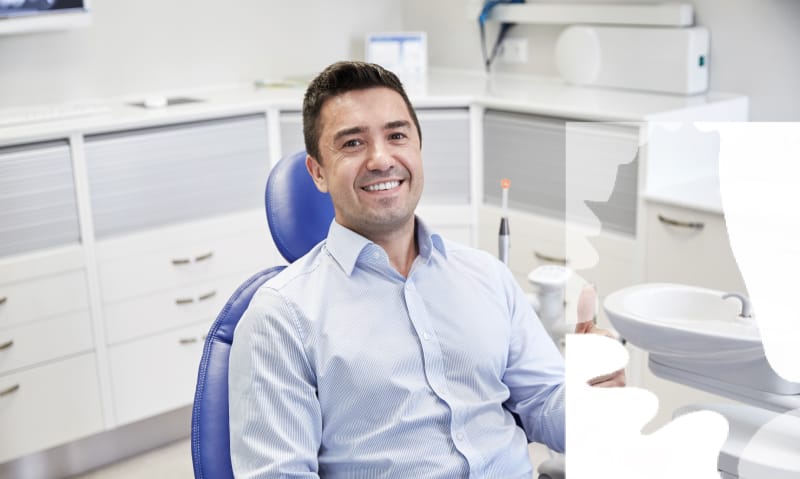3 Parts of a Comprehensive Dental Restoration at Valley Dental Clinic

How Dr. Rob Restores Decayed and Damaged Teeth
Tooth enamel is the hardest substance in the human body, but bacteria, plaque, and physical impact can leave teeth damaged and vulnerable. Tooth decay and gum disease are the two biggest threats to adult oral health, and both problems can lead to permanent enamel damage, gum recession, and eventual tooth loss without treatment.
When damage does happen, restorative dental care can save the day. In fact, preventive care aside, restorative dentistry is the most popular field of dental care.
At Valley Dental Clinic, Dr. Rob’s approach to comprehensive dental restoration ensures the underlying problem is diagnosed, the damage is effectively treated, and follow-up care is provided to prevent relapse.
Let’s dive into the three steps involved in dental restorations at our family-friendly Wasilla dental clinic.
Step 1: Dental Evaluation and Treatment Planning
Restorative dental care will be necessary to restore optimal oral health if you have decayed, damaged, injured, or missing teeth. The sooner you get help, the easier treatment will be, and the faster your oral health can recover.
The very first time you visit Dr. Rob he’ll perform a thorough examination to evaluate all aspects of your current smile, including:
- Obvious and hidden signs of damage visually and via x-ray analysis
- Medical history, including changes in systemic disease
- Lifestyle habits that impact oral health and increase risks
- Old dental restorations that need to be replaced
- Signs of tooth decay, gum disease, and oral cancer
During the examination, Dr. Rob will use an intra-oral camera to see exactly what’s going on in your smile and explain his findings. Finally, he’ll put together a treatment plan to solve the issues he’s noticed in your smile.
Tooth Decay
Any signs of decay or crumbling tooth enamel will need to be removed. Dental fillings are used to treat cavities while more extensive decay damage may need a dental crown instead.
Dental crowns come in several materials, but Valley Dental Clinic is proud to offer zirconia crowns, popular for their exceptional strength and beauty.
Crowns are also used in tandem with single dental implants and to protect teeth after root canal therapy, which may be necessary if your tooth’s pulp has been infected.
Chipped/Cracked Teeth
Fillings and dental crowns can also be used to revive teeth that have chips, cracks, and similar superficial damage, but that isn’t the only option. Dr. Rob can also use cosmetic dental care solutions, like Bioclear, to restore the beauty of your teeth after superficial damage. Bioclear is a modern, beautiful, single-visit, cost-saving solution used to treat a wide variety of issues such as cavities and cracks as well as stains, gaps, cracks, and teeth that are misshapen.
Unsaveable Teeth
A tooth is sometimes not salvageable due to severe decay and gum disease. In these situations, the best solution for protecting your smile is to have the tooth extracted and replaced with a prosthetic option to fill the gap.
Missing Teeth
After extraction, it’s important to replace them with some sort of restoration to ensure full functionality when speaking and chewing.
Dr. Rob is highly educated and certified in advanced dental implant restorations, including single implants, implant-supported dentures, and implant-supported dental bridges. Dental implant options are the superior solution for missing teeth, but patients who are not candidates for surgery can opt for traditional dentures or dental bridges.
Step 2: Treatment Appointments
After Dr. Rob has created a blueprint for your comprehensive dental restoration, you can book your first treatment appointment.
The total number of treatment appointments depends on which procedures Dr. Rob has recommended for your smile. Completing mild to moderate restorative or cosmetic care may only take a single visit. If you require several procedures or dental implant surgery, you’ll visit Dr. Rob several times before completing your smile makeover.
We usually start with basic restorative care first, such as fillings. If you require dental crowns, implants, or dentures, we’ll also take digital impressions to map your smile anatomy to ensure your restoration or implants are the perfect fit.
Crowns require teeth to be prepped before a temporary crown is placed. You’ll wait about two weeks before your permanent zirconia crown arrives from the lab and can be placed.
Dental implant restorations usually require the most appointments, especially if Dr. Rob recommends a bone graft prior to implant placement. After your examination, he’ll be able to give you an accurate estimate based on your unique needs.
Step 3: Recovery and Follow-Up Visits
After all of your treatment appointments are complete, you may need time to heal. The more invasive a procedure is, the longer the healing time. For example, it might take a couple of days to feel 100% back to normal after a root canal and crown, while dental implant surgery requires several months of healing to allow for bone growth.
Dr. Rob will have you return for a follow-up visit to ensure you’re healing well and that your restoration is comfortable. He’ll also create a preventive care plan to monitor your long-term oral health, including guidelines for at-home care. Checkups and cleanings every six months are standard, but if you are at high risk for plaque build-up or gum disease, he may recommend visits every three to four months instead.
Start your journey toward a full, healthy smile at Valley Dental Clinic.
See how Dr. Rob and his team can help you attain a new level of oral health through general, restorative, and cosmetic dental care services. Schedule your appointment today via phone or online request.